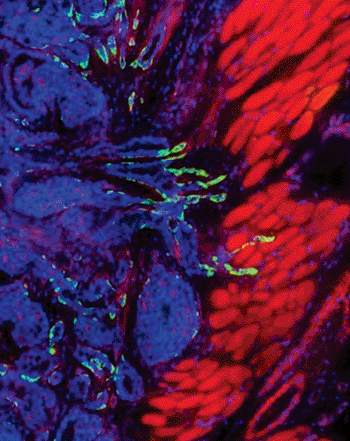Breast Cancer Metastasis Depends on Expression of Leader Cell Protein
By LabMedica International staff writers
Posted on 24 Dec 2013
Cell biologists have identified a protein that they regard as a potential drug target in a unique class of breast cancer cells that lead the process of metastasis into surrounding tissues. Posted on 24 Dec 2013
Carcinomas typically migrate into normal tissues as a cohesive multicellular unit, a process termed collective invasion. It has been unclear how different subpopulations of cancer cells contributed to this process.

Image: A breast tumor (blue) uses leader cells (green) to invade muscle tissue (red) in a mouse (Photo courtesy of Dr. Kevin Cheung, Cell).
Investigators at Johns Hopkins University (Baltimore, MD, USA) developed three-dimensional organoid assays to identify the most invasive cancer cells in primary breast tumors. They reported in the December 12, 2013, online edition of the journal Cell that collective invasion was led by specialized cancer cells (leader cells) that were defined by their expression of basal epithelial genes, such as cytokeratin-14 (K14) and p63. Furthermore, examination of human tumor samples showed that K14-expressing cells led collective invasion in the major human breast cancer subtypes.
To confirm the role of K14 in the invasive process, the investigators used gene therapy techniques to block its expression in some tumor lines. Cancer cells with blocked K14 expression and similar but untreated cancer cells were then implanted into different sites on the same mouse. Examination of the resulting tumors showed that leader cells were present in the K14-expressing tumors and were leading vigorous invasions into normal tissue. In the tumors with blocked K14 expression essentially no invasions occurred.
"Metastasis is what most threatens breast cancer patients, and we have found a way to stop the first part of the process in mice," said senior author Dr. Andrew Ewald, assistant professor of cell biology at Johns Hopkins University. "We are still several years away from being able to use these insights to help patients with breast cancer, but we now know which tumor cells are the most dangerous, and we know some of the proteins they rely on to do their dirty work. Just a few leader cells are sufficient to start the process of metastasis, and they require K14 to lead the invasion."
Related Links:
Johns Hopkins University














